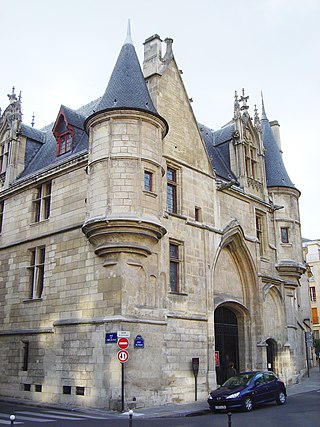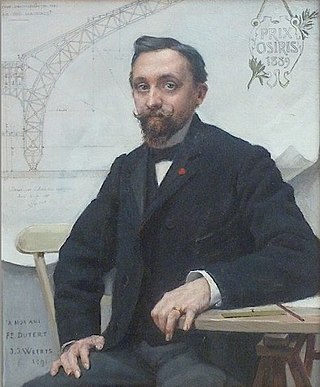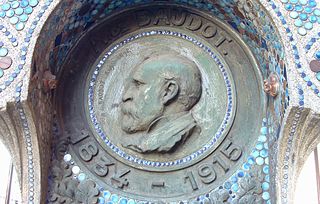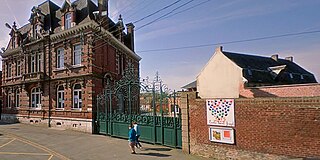
The Marais is a historic district in Paris, France. It spreads across parts of the 3rd and 4th arrondissements on the Rive Droite, or Right Bank, of the Seine. Having once been an aristocratic district, it is home to many buildings of historic and architectural importance. It lost its status as a fashionable district in the late 18th century, with only minor nobles calling the area home. After the French Revolution, the district fell into disrepair and was abandoned by nobility. After a long period of decay, the district has undergone transformation in recent years and is now once again amongst the more fashionable areas of Paris, known for its art galleries, upscale restaurants and museums.

The Trocadéro, site of the Palais de Chaillot, is an area of Paris, France, in the 16th arrondissement, across the Seine from the Eiffel Tower. It is also the name of the 1878 Trocadéro Palace which was demolished in 1937 to make way for the Palais de Chaillot. The hill of the Trocadéro is the hill of Chaillot, a former village.

The Musée Carnavalet in Paris is dedicated to the history of the city. The museum occupies two neighboring mansions: the Hôtel Carnavalet and the former Hôtel Le Peletier de Saint Fargeau. On the advice of Baron Haussmann, the civil servant who transformed Paris in the latter half of the 19th century, the Hôtel Carnavalet was purchased by the Municipal Council of Paris in 1866; it was opened to the public in 1880. By the latter part of the 20th century, the museum was full to capacity. The Hôtel Le Peletier de Saint Fargeau was annexed to the Carnavalet and opened to the public in 1989.

The Palais de Chaillot is a building at the top of the Chaillot hill in the Trocadéro area in the 16th arrondissement of Paris, France.

Pierre-Louis Moreau-Desproux was a pioneering French neoclassical architect.

Paul Sédille was a French architect and theorist; and designed the 1880 reconstruction of the iconic Magasins du Printemps department store in Paris.

Marie-Joseph Peyre was a French architect who designed in the Neoclassical style.

Saint-Lazare Prison was a prison in the 10th arrondissement of Paris, France. It existed from 1793 until 1935 and was housed in a former motherhouse of the Vincentians.

The Cité de l'architecture et du patrimoine is a museum of architecture and monumental sculpture located in the Palais de Chaillot (Trocadéro), in Paris, France. Its permanent collection is also known as Musée national des monuments français. It was established in 1879 by Eugène Viollet-le-Duc. The museum was renovated in 2007 and covers 9,000 square meters of gallery space. Alongside temporary exhibitions, it is made of three permanent exhibits :

Henri Sauvage was a French architect and designer in the early 20th century. He was one of the most important architects in the French Art nouveau movement, Art Deco, and the beginning of architectural modernism. He was also a pioneer in the construction of public housing buildings in Paris. His major works include the art nouveau Villa Majorelle in Nancy, France and the art-deco building of the La Samaritaine department store in Paris.
Edmond Jean-Baptiste Paulin was a French architect. As a young man, he became known for his reconstruction of the Baths of Diocletian. Later he taught at the National School of Fine Arts, and designed pavilions for two world expositions.

Eugène Alfred Hénard was a French architect and a highly influential urban planner. He was a pioneer of roundabouts, which were first introduced in Paris in 1907.
The Rue Rambuteau is a street in Paris, France, named after the Count de Rambuteau who started the widening of the road prior to Haussmann's renovation of Paris. The philosopher Henri Lefebvre lived on the street and observed from his window the rhythms of everyday life at the intersection located behind the Centre Georges Pompidou.

Charles Louis Ferdinand Dutert was a French architect.

Joseph-Eugène-Anatole de Baudot was a French architect and a pioneer of reinforced-concrete construction. He was a prolific author, architect for diocesan buildings, architect for historical monuments, and a professor of architecture. He is known for the church of Saint-Jean-de-Montmartre in Paris, the first to be built using concrete reinforced with steel rods and wire mesh.
Joseph-Auguste Lafollye (1828-1891) was a French architect. He is known for his restoration of the Château de Pau and other major public buildings.

Léon-Emile Bazin (1900-1976) was a French architect.

Fernand Sabatté was a French painter and sculptor who is best known for his architectural painting and portrait work, as well as salvaging church monuments and bombed out churches in the zone rouge during World War I.

École Saint-Joseph is a French Catholic school ruled by the Ministry of National Education and based in Solesmes, Nord department, within the Hauts-de-France bordering Belgium. It was founded in 1892 by the Roman Catholic Archdiocese of Cambrai of the Latin Rite and is attached to the Cambrai - Le Cateau-Cambrésis educational district contractually regulated by Lille. It is part of the Saint-Pierre consortium comprising schools in three other cities. The manor is a regional landmark due to its typical architecture. As of September 2018, it has more than three hundred pupils supervised by a staff of around forty agents.

The Hôtel de Ratabon was a Parisian hôtel particulier, constructed in 1664 to the designs of the architect Pierre Le Muet for the French government official Antoine de Ratabon. It was located on a site, which at the time was between the western border of the garden of the Palais-Royal and the rue de Richelieu and is now at 10 rue de Richelieu in the 1st arrondissement of Paris. Antoine de Ratabon died in his house in 1670. It was destroyed in 1873.




















